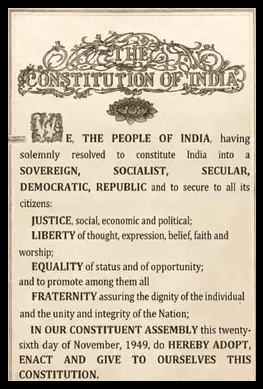
Introduction
- Adoption Dates of Preamble:
– Into Constituent Assembly: January 22, 1947
– Formally into Constitution: November 26, 1949
- Influence of American Constitution: American Constitution set the precedent with a Preamble.
- Preamble’s Role: Serves as a brief summary of the Constitution.
- Indian Preamble’s Origin: Rooted in the ‘Objectives Resolution’ drafted by Pandit Nehru.
- Often called the ‘Identity card of the Constitution.’
Text of the Preamble

Note: Preamble can also be read at this Official Governement Website
Ingredients of the Preamble
- Source of Authority: Derives authority from the people of India.
- Nature of Indian State: Sovereign, socialist, secular, democratic, and republican.
- Objectives: Justice, liberty, equality, fraternity.
Key Words in the Preamble
- Sovereign: Signifies India’s independence and self-governance.
- Socialist: Reflects commitment to social and economic justice.
- Secular: Emphasizes equal treatment of all religions.
- Democratic: Establishes a government based on popular sovereignty.
- Republic: Denotes an elected head and no privileged class.
Significance of the Preamble
- Fundamental Values and Philosophy: Houses the core principles of the Constitution.
- Vision of Framers: Reflects the framers’ aspirations for a just and equitable society.
- Understanding Constitution’s Purpose: Serves as a guide for interpreting the Constitution.
Preamble as Part of the Constitution
- Initial Controversy: Debate over whether it’s a legally binding part of the Constitution.
- Later Recognition: Acknowledged as an integral part guiding interpretation.
Major Court Hearings
- Berubari Union Case (1960):
- Initially viewed Preamble as non-constitutional.
- Kesavananda Bharati Case (1973):
- Preamble’s basic features unalterable.
- Established Preamble’s integral status.
- LIC of India Case (1995):
- Reaffirmed Preamble’s integration into the Constitution.
Amending the Preamble
- Amendment under Article 368:
- Permissible with limits specified in Article 368.
- Limits on Amendment:
- Core Preamble principles cannot be altered.
- 1976 Amendment:
- Done by 42nd Constitutional Amendment Act
- The only ammendment of Preamble till now
- Added words “Socialist, Secular, Integrity” in the Preamble
- Deemed valid and aligned with the socio-political context.
MCQs
1. When was the Preamble of the Indian Constitution formally adopted into the Constitution?
2. What is the influence of the American Constitution on the Indian Constitution’s Preamble?
3. What is the primary role of the Preamble in the Indian Constitution?
4. What is the origin of the Indian Preamble?
5. What is the Preamble often referred to as?
6. What are the key words used in the Preamble of the Indian Constitution?
7. What does the term “Sovereign” signify in the Preamble?
8. What does the term “Socialist” reflect in the Preamble?
9. What does the term “Secular” emphasize in the Preamble?
10. What does the term “Democratic” establish in the Preamble?
